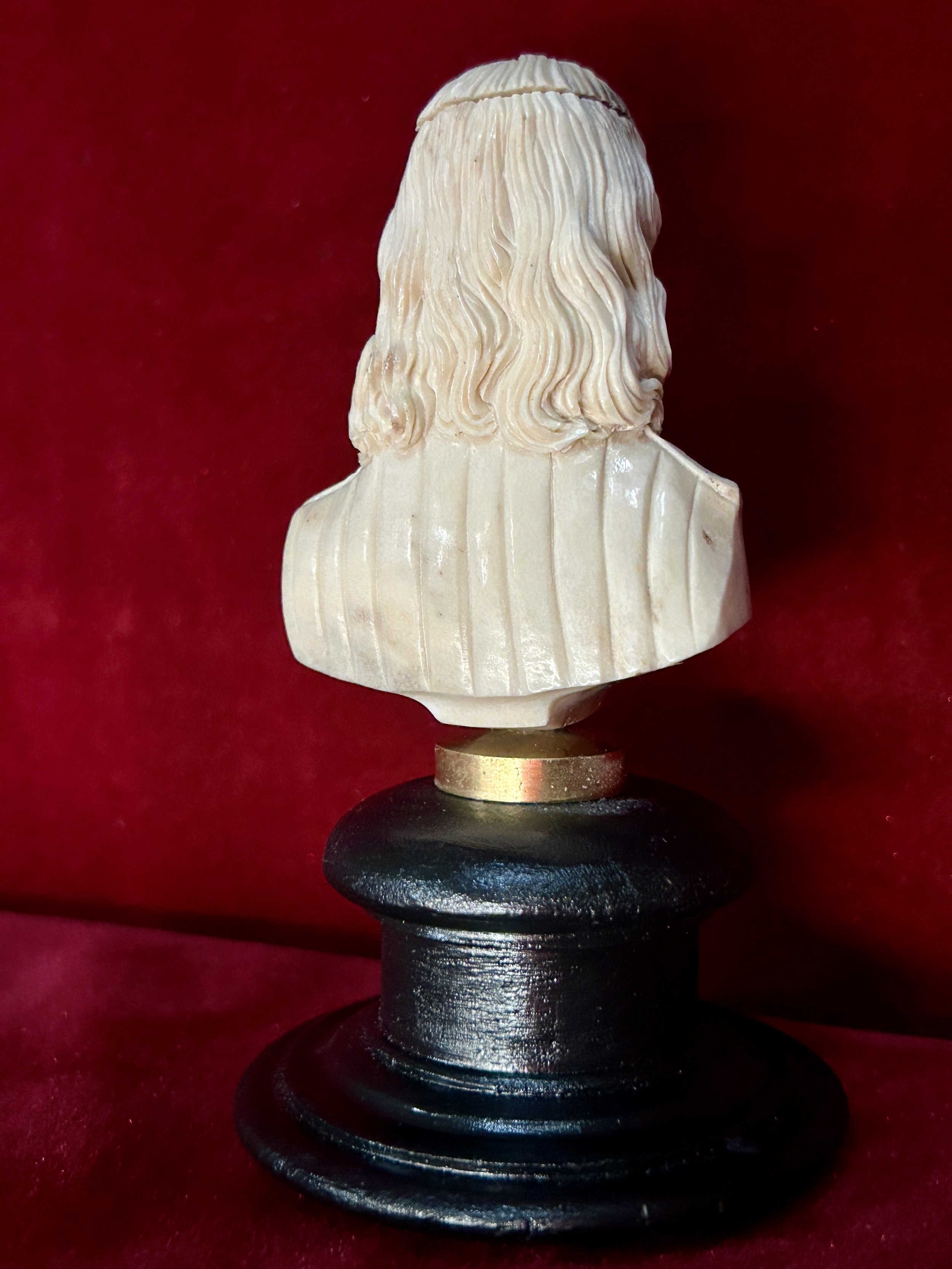 Image 1 of 14
Image 1 of 14

 Image 2 of 14
Image 2 of 14

 Image 3 of 14
Image 3 of 14

 Image 4 of 14
Image 4 of 14

 Image 5 of 14
Image 5 of 14

 Image 6 of 14
Image 6 of 14

 Image 7 of 14
Image 7 of 14

 Image 8 of 14
Image 8 of 14

 Image 9 of 14
Image 9 of 14

 Image 10 of 14
Image 10 of 14

 Image 11 of 14
Image 11 of 14

 Image 12 of 14
Image 12 of 14

 Image 13 of 14
Image 13 of 14

 Image 14 of 14
Image 14 of 14















19th Century French Carved Horn Memento Mori Vanitas Skull Bust of René Descartes
Late 19th century French carved bone memento mori vanitas bust of philosopher René Descartes, with detachable face & head revealing a skull beneath.
Miniature bust featuring high quality & intricate carving. Carved deer antler (not Ivory).
Rare and very unusual memento mori vanitas sculpture.
An impressive & striking visual display piece for a cabinet of curiosities.
The face and top of the head of René Descartes detaches to reveal the skull beneath. Can be displayed with the face detached or attached, as in the photos.
Set on a period ebony wooden base with brass top.
A vanitas is a symbolic work of art showing the transience of life, the futility of pleasure, and the certainty of death. The skull was the symbol of death from the 1500s onwards; previously death was represented as a skeleton. Skulls were very popular in the Baroque period and were not only an essential part of any Wonderland Room (Wunderkammer), but also acted as contemplative reminders of mortality.
Total Height: 12 cm / Sculpted Bust H: 7 cm x W: 5 cm / Base H: 5 cm x W: 7 cm.
Provenance: From a private collection in France.
René Descarets (1596 – 1650) was a French philosopher, scientist, and mathematician, widely considered a seminal figure in the emergence of modern philosophy and science. Mathematics was paramount to his method of inquiry, and he connected the previously separate fields of geometry and algebra into analytic geometry. His best known philosophical statement is "cogito, ergo sum" ("I think, therefore I am").
We currently have 3 similar memento mori miniature carved busts that display very impressively as a set. See last photo.
Late 19th century French carved bone memento mori vanitas bust of philosopher René Descartes, with detachable face & head revealing a skull beneath.
Miniature bust featuring high quality & intricate carving. Carved deer antler (not Ivory).
Rare and very unusual memento mori vanitas sculpture.
An impressive & striking visual display piece for a cabinet of curiosities.
The face and top of the head of René Descartes detaches to reveal the skull beneath. Can be displayed with the face detached or attached, as in the photos.
Set on a period ebony wooden base with brass top.
A vanitas is a symbolic work of art showing the transience of life, the futility of pleasure, and the certainty of death. The skull was the symbol of death from the 1500s onwards; previously death was represented as a skeleton. Skulls were very popular in the Baroque period and were not only an essential part of any Wonderland Room (Wunderkammer), but also acted as contemplative reminders of mortality.
Total Height: 12 cm / Sculpted Bust H: 7 cm x W: 5 cm / Base H: 5 cm x W: 7 cm.
Provenance: From a private collection in France.
René Descarets (1596 – 1650) was a French philosopher, scientist, and mathematician, widely considered a seminal figure in the emergence of modern philosophy and science. Mathematics was paramount to his method of inquiry, and he connected the previously separate fields of geometry and algebra into analytic geometry. His best known philosophical statement is "cogito, ergo sum" ("I think, therefore I am").
We currently have 3 similar memento mori miniature carved busts that display very impressively as a set. See last photo.
Late 19th century French carved bone memento mori vanitas bust of philosopher René Descartes, with detachable face & head revealing a skull beneath.
Miniature bust featuring high quality & intricate carving. Carved deer antler (not Ivory).
Rare and very unusual memento mori vanitas sculpture.
An impressive & striking visual display piece for a cabinet of curiosities.
The face and top of the head of René Descartes detaches to reveal the skull beneath. Can be displayed with the face detached or attached, as in the photos.
Set on a period ebony wooden base with brass top.
A vanitas is a symbolic work of art showing the transience of life, the futility of pleasure, and the certainty of death. The skull was the symbol of death from the 1500s onwards; previously death was represented as a skeleton. Skulls were very popular in the Baroque period and were not only an essential part of any Wonderland Room (Wunderkammer), but also acted as contemplative reminders of mortality.
Total Height: 12 cm / Sculpted Bust H: 7 cm x W: 5 cm / Base H: 5 cm x W: 7 cm.
Provenance: From a private collection in France.
René Descarets (1596 – 1650) was a French philosopher, scientist, and mathematician, widely considered a seminal figure in the emergence of modern philosophy and science. Mathematics was paramount to his method of inquiry, and he connected the previously separate fields of geometry and algebra into analytic geometry. His best known philosophical statement is "cogito, ergo sum" ("I think, therefore I am").
We currently have 3 similar memento mori miniature carved busts that display very impressively as a set. See last photo.